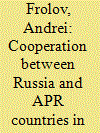|
|
|
Sort Order |
|
|
|
Items / Page
|
|
|
|
|
|
|
| Srl | Item |
| 1 |
ID:
098129


|
|
|
|
|
| Publication |
2010.
|
| Summary/Abstract |
The article surveys international cooperation efforts to dismantle decommissioned submarines of the Russian Pacific Fleet. Russia's difficult financial and economic situation and its inability to dismantle its multi-purpose nuclear submarines forced it to seek assistance from Japan, in which later also joined three other APR countries - Australia, South Korea, and New Zealand. Since cooperative efforts were first launched, foreign funds have been used to dismantle three nuclear submarines, build a radioactive waste processing plant, and a contract has been signed for dismantling two more nuclear submarines.
|
|
|
|
|
|
|
|
|
|
|
|
|
|
|
|
| 2 |
ID:
169455


|
|
|
|
|
| Summary/Abstract |
Nuclear disarmament is often seen as eventually requiring access to nuclear warheads or to the warhead-dismantlement process to verify that a state has not hidden weapons or weapon-materials despite promising to disarm. This article suggests this view is misplaced, and that what is needed is a verification mechanism able to provide reliable assurances of the absence of fissile materials available for use in weapons after a state has disarmed. Such a mechanism will need an initial declaration of the amount of fissile materials held by a state for all purposes, military and civilian. In a state with a nuclear arsenal awaiting elimination, this declaration would have to include materials that may not be available for verification because they are in nuclear weapons or are in other classified or proliferation-sensitive forms. This article describes a verification arrangement that does not require access to materials in weapons and in sensitive forms while still allowing checks on the overall accuracy of the declaration. Verification of the completeness and correctness of the declaration is deferred to the time when the weapons-relevant material enters the disposition process, at which point it no longer has any sensitive attributes. By removing the focus on monitoring warheads and dismantlement, this new approach could provide a more manageable path to nuclear disarmament.
|
|
|
|
|
|
|
|
|
|
|
|
|
|
|
|
| 3 |
ID:
169456


|
|
|
|
|
| Summary/Abstract |
Researchers have recently proposed a new approach to nuclear-arms-control verification, dubbed “deferred verification.” The concept forgoes inspections at sensitive nuclear sites and of nuclear weapons or components in classified form. To implement this concept, a state first divides its nuclear program into a closed segment and an open segment. The total fissile-material inventory in the closed segment, which includes the weapon complex, is known and declared with very high accuracy. Essentially no inspections take place in the closed segment. In contrast, inspectors have access to the open segment, which includes in particular the civilian nuclear sector. The fissile-material inventory in the open segment is known with less accuracy, but uncertainties can be reduced over time using nuclear-archaeology methods. Deferred verification relies primarily on established safeguards techniques and avoids many unresolved verification challenges, such as the need for information barriers for warhead confirmation measurements. At the same time, deferred verification faces some unique challenges. Here, we explore some of these challenges and offer possible solutions; to do so, we examine possible noncompliance strategies in which a state would seek to withhold a higher-than-declared inventory.
|
|
|
|
|
|
|
|
|
|
|
|
|
|
|
|
| 4 |
ID:
076714


|
|
|
|
|
| Publication |
2006.
|
| Summary/Abstract |
South Africa's transition away from being a U.S. ally toward being a neutral country was followed by the development and then rollback of a nuclear weapons program. In South Africa's case, paranoia that the United States was abandoning it was a significant motive for going nuclear. Realism does not fully explain South Africa's desire for nuclear weapons, since the country faced no major strategic threats. Paranoia about communists and the loss of the United States as a major ally increased South Africa's sense of insecurity, thus it began to develop weapons and missiles. U.S. pressure increased in the late 1980s, and in 1989 the apartheid government began the process of surrendering power. South Africa signed the NPT, and in 1990 and 1991, it unilaterally disarmed. Lessons from the South Africa case include the critical role played by leaders in setting the direction of a country's strategic policy, and the unintended consequences of Western programs to promote peaceful energy. Democratic reforms may prove to be a successful long-term factor in reversing the development of nuclear weapons.
|
|
|
|
|
|
|
|
|
|
|
|
|
|
|
|
|
|
|
|
|